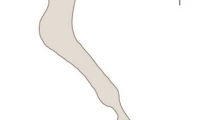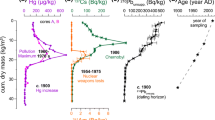Abstract
Seasonal changes of phytoplankton were followed over 3 years (1985–87) in a shallow, unstratified and calcareous upland lake.The phytoplankton was of low to moderate abundance and generally dominated by phytoflagellates. Seasonality involved a winter minimum of abundance, a spring maximum of diatoms, and often brief increases in summer that included blue-greens, especially the colonial Gloeotrichia echinulata. Some components were of benthic origin. Seasonal growth of the main component of the phytobenthos, Chara globularisvar. virgata, caused a regular summer depletion in lake water of Ca2+ and HCO3 - (alkalinity) by associated CaCO3 deposition, and a more extreme (and unusual) depletion of K+. Chemical analysis of Chara biomass and of underlying sediments indicated a large benthic nutrient stock, much surpassing that represented by the phytoplankton. Growth in this biomass, and the magnitude of water-borne inputs, influenced the removals of Ca2+, K+ and inorganic N. The phytoplankton was probably limited by a low-P medium, to which co-precipitation of phosphate with CaCO3 may have contributed. A vernal depletion of Si was probably limiting to diatom growth, and appeared to be mainly induced by benthic rather than planktonic diatoms. Examples of long-term change in composition of the phytoplankton and phytobenthos are noted and discussed in relation to the interaction of these components, nutrient enrichment, and possible alternative stable states.
Similar content being viewed by others
References
Allen, S. E., A. Carlisle, E. J. White & C. C. Evans, 1968. The plant nutrient content of rainwater. J. Ecol. 56: 497–504.
Bailey-Watts, A. E., 1982. The composition and abundance of phytoplankton in Loch Leven (Scotland) 1977–1979 and a comparison with the succession in earlier years. Int. Rev. ges. Hydrobiol. Hydrogr. 67: 1–25.
Barber, H. G., 1982. A gathering of diatoms from Malham Tarn. Microscopy 34: 374–380.
Barbosa, F. A. R., 1989. Evidence from algal bioassays of seasonal nutrient limitations in two English lakes. Hydrobiologia 188/189: 211–228.
Dillon, P. J. & F. H. Rigler, 1974. The phosphorus-chlorophyll relationship in lakes. Limnol. Oceanogr. 19: 767–773.
Forsell, L. & K. Pettersson, 1995. On the seasonal migration of the cyanobacterium Gloeotrichia echinulata in Lake Erken, Sweden, and its influence on the pelagic population. Mar. Freshwat. Res. 46: 287–293.
Fryer, G., 1991. Malham Tarn. Biologist 38: 81–83.
Gibson, C. E., Y. Wu & D. Pinkerton, 1995. Substance budgets of an upland catchment: the significance of atmospheric phosphorus inputs. Freshwat. Biol. 33: 385–392.
Heaney, S. I., D. V. Chapman & H. R. Morison, 1983. The role of the cyst stage in the seasonal cycle of the dinoflagellate Ceratium hirundinella within a small productive lake. Brit. Phycol. J. 18: 47–59.
Holmes, P. F., 1965. The natural history of Malham Tarn. Field Studies 2: 199–223.
Knudson, B. M., 1957. Ecology of the epiphytic diatom Tabellaria flocculosa (Roth) Kótz. var. flocculosa in three English lakes. J. Ecol. 45: 93–112.
Kufel, L. & T. Ozimek, 1994. Can Chara control phosphorus cycling in Lake Luknajno (Poland)? Hydrobiologia 275/276: 277–283.
Littlefield, L. & C. Forsberg, 1965. Absorption and translocation of phosphorus-32 by Chara globularis Thuill. Physiol. Plant. 18: 291–296.
Lund J. W. G., 1961. The algae of the Malham Tarn district. Field Studies 1 (3): 85–119.
Mackereth F. J. M., J. Heron & J. F. Talling, 1989. Water Analysis: Some Revised Methods for Limnologists. Second impression. Freshwater Biological Association Sci. Publ. 36: 124 pp.
Manley, G., 1956. The climate at Malham Tarn. Annual Report of the Council for the Promotion of Field Studies (1955–1956): 43–56.
Moore, J. A., 1986. Charophytes of Great Britain and Ireland. Botanical Society of the British Isles Handbook No. 5: 140 pp.
Pentecost, A., 1983. The distribution of daughter colonies and cell numbers in a natural population of Volvox aureus Ehrenb. Ann. Bot. 52: 769–776.
Pentecost, A., 1984. The growth of Chara globularis and its relation to calcium carbonate deposition in Malham Tarn. Field Studies 6: 53–58.
Pentecost, A., 1998 Phosphorus fractionation in the sediments of Malham Tarn, North Yorkshire. Field Studies 9: 337–342.
Pentecost, A., 1999. The Freshwater Algae and Free-Living Protozoa Recorded within a 5 km Radius of Malham Tarn Field Centre. Edition 1. Division of Life Sciences, King's College London.
Pigott, M. E. & C. D. Pigott, 1959. Stratigraphy and pollen analysis of Malham Tarn and Tarn Moss. Field Studies 1 (1): 84–101.
Pitty, A. F., 1971. Biological activity and the uptake and redeposition of calcium carbonate in natural water. Envir. Lett. 1: 103–109.
Proctor, M. C. F., 1995. Hydrochemistry of the raised bog and fens at Malham Tarn National Nature Reserve, Yorkshire, U.K. In Hughes, J. & L. Heathwaite (ed.), Hydrology and Hydrochemistry of British Wetlands. Wiley, Chichester: 273–289.
Round, F. E., 1953. An investigation of two benthic algal communities in Malham Tarn, Yorkshire. J. Ecol. 41: 174–197.
Scheffer, M., 1998. Ecology of Shallow Lakes. Chapman & Hall: 357 pp.
Sinker, C. A., 1960. The vegetation of the Malham Tarn Area. Proc. Leeds Phil. Lit. Soc. 8: 139–175.
Sledge, W. A., 1936. The aquatic vegetation of Malham Tarn. Naturalist, Lond. (1936): 217–219.
Sondergaard, M. & B. Moss, 1998. Impact of submerged macrophytes on phytoplankton in shallow freshwater lakes. In Jeppersen, E., M. Sondegaard & K. Christoffersen (eds), The Structuring Role of Submerged Macrophytes in Lakes. Springer: 115–132.
Sutcliffe, D. W., T. R. Carrick, J. Heron, E. Rigg, J. F. Talling, C. Woof & J. W. G. Lund, 1982. Long-term and seasonal changes in the chemical composition of precipitation and surface waters of lakes and tarns in the English Lake District. Freshwat. Biol. 12: 451–506.
Talling, J. F., 1971. The underwater light climate as a controlling factor in the production ecology of freshwater phytoplankton. Mitt. int. Ver. theor. angew. Limnol. 19: 214–243.
Talling, J. F., 1993. Comparative seasonal changes, and inter-annual variability and stability, in a 26-year record of total phytoplankton biomass in four English lake basins. Hydrobiologia 268: 65–98.
Talling, J. F. & J. E. Parker, 2002 Space–time configurations of solute input and biological uptake in river systems traversing limestone uplands (Yorkshire Dales, northern England). Hydrobiologia 487: 153–165.
Water Research Association, 1970. River Flow Measurement by Dilution Gauging. Water Research Association, Medmenham, Bucks, Technical Paper TP74: 85 pp.
Woof, C. & E. Jackson, 1988. Some aspects of the water chemistry in the area around Malham Tarn. Field Studies 7: 159–187.
Author information
Authors and Affiliations
Rights and permissions
About this article
Cite this article
Talling, J.F., Parker, J.E. Seasonal dynamics of phytoplankton and phytobenthos, and associated chemical interactions, in a shallow upland lake (Malham Tarn, northern England). Hydrobiologia 487, 167–181 (2002). https://doi.org/10.1023/A:1022934705359
Issue Date:
DOI: https://doi.org/10.1023/A:1022934705359




